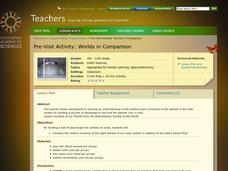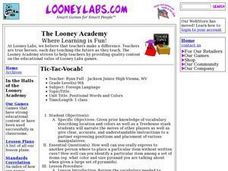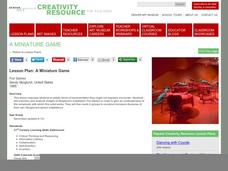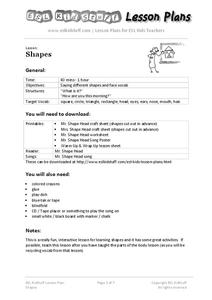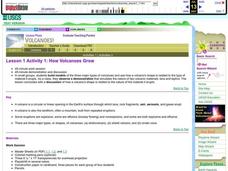Curated OER
Build an Anchialine Pond
Students explore biology by conducting a nature experiment. In this pond examination lesson plan, students utilize recycled materials, play-doh and water to recreate a pond and its inhabitants. Students identify the different elements...
K-State Research and Extensions
The Crusty Earth
Geology rocks — literally! A geology chapter offers eleven activities at four different levels. Scholars enjoy completing hands-on experiments before applying critical thinking skills following a share, process, generalize, apply,...
Science 4 Inquiry
Genetics, Genetics, and More Genetics: Exploring Independent Assortment and Non-Mendelian Genetics
Two individuals share 99.9 percent of their genetic codes, yet diversity is observed everywhere. Young scientists learn about diversity through hands-on activities and an experiment. They apply the concepts of independent assortment and...
Curated OER
Introduction of Primary Sources
First graders create two personal artifacts to add to a primary source shoebox that represents information about themselves. The first draw a self-portrait then build an artifact from Play-Doh and pipe cleaners to represent something...
Curated OER
Levels of Organization
Students brainstorm a list of all the functions organisms carry out and how they carry them out. In groups, they are given the smallest and highest level of organization in organisms and are to fill in the missing spaces. To end the...
Curated OER
Creating Animal Prints
Students investigate the habits of animals by studying their prints. In this animal life lesson, students investigate the different types of tracks left from animals by researching the Internet. Students utilize clay or...
Columbus City Schools
The Mystery of Earth’s History
Every living creature can leave a fossil record, yet most fossils belong to extinct organisms rather than ones currently living. Scholars learn about dating rock layers, fossils, and the environment of the past. Pupils understand that...
Curated OER
The Skeletal System
Third graders are introduced to the human skeletal system. Using play-doh, they discover what happens to the bones of the body as a person moves and how broken bones heal. After reading examples, they examine the different types of...
Pacific Science Center
Worlds in Comparison
Young astronomers follow a step-by-step procedure for dividing a lump of dough into parts, resulting in a scaled volume set of puny planets. Along with the printable directions is a template chart of planet names on which learners can...
Curated OER
Yellow Pod
Students use appropriate skills to design and conduct scientific investigation. They sort and classify various ingredients and analyze their investigation. Finally, students describe the observable states of matter, bot solids and liquids.
Center for Learning in Action
Introducing Physical and Chemical Changes
Young scientists investigate chemical and physical changes to the states of matter—gas, liquid, and solid—as well as solutions and suspensions with a variety of demonstrations, grand conversation, and an interactive quiz to check for...
Curated OER
Tic-Tac-Vocab!
Ninth graders review the vocabulary needed to discuss colors and directions and watch a teacher demonstration of a game called tic-tac-doh. They practice playing with partner while student observers describe the moves in target language,...
Curated OER
Money Matters
Students explore the concept of money. In this money lesson, students role play an economy. Students are divided into three categories- the money factory, construction workers, and the grocery store. Students work cooperatively to make...
Curated OER
Life Cycle of the Plant - The Pumpkin
First graders access prior knowledge about pumpkins and read the story Pumpkin, Pumpkin. They will sequence the life cycle of the pumpkin through the use of picture cards and then sing a song about the life cycle of the pumpkin and plant...
Curated OER
Lesson Plan: A Miniature Game
Art inspires art, as children work to understand artistic forms that come from the imagination. They analyze the installation piece, Fox Games and then discuss the design process. They then use clay to create imaginative dioramas,...
ESL Kid Stuff
Zoo Animals
Let's go to the zoo! Take a pretend trip to the zoo with a lesson plan about animals that live at the zoo. Kids sing, match animals, practice animal sounds, and read about Sammy the Snake's birthday party.
ESL Kid Stuff
Shapes
Work on shapes and body parts at the same time with a fun set of activities. Kids sing and read about Mr. Shape Head, who has shapes on his face, before making their own Mr. Shape Head.
Curated OER
How Volcanoes Grow
Young scholars build models of the three major types of volcanoes and see how a volcano's shape is related to the type of material it erupts. As a class, they observe a demonstration that simulates the nature of two volcanic materials:...
Curated OER
Atoms and Elements: An Introduction
Learners are able to discuss the difference between a proton, a neutron and an electron. They also can explain the difference between an ionic and a covalent bond. Students know the main structure of atoms and molecules. Student are able...
Curated OER
How Volcanoes Grow
Students create models of the three major types of volcanoes and determine how a volcano's shape is related to the type of material erupted. They then observe a demonstration that simulates the nature of two volcanic materials: lava and...
Curated OER
Hungary: The Landscape
Students work in small groups to create a topographic map of Hungary. The map will include labeled line drawing of the bordering countries. Hungary should be three dimensional, made of salt and flour clay. The mountains, plains and...
Curated OER
Italy: The Landscape
Students work in small groups to create a topographic map of Italy. They must include labeled line drawings of bordering countries and bodies of water. Students use salt and flour clay to make Italy three dimensional, showing the many...
Curated OER
Malta: The Landscape
Students work in small groups to create a topographic map of Malta. They must include labeled line drawings of bordering countries and bodies of water. Students use salt and flour clay to make Malta three dimensional, showing the nearest...
NorthEast Ohio Geoscience Education Outreach
Investigation of Plate Boundaries
Demonstrate the movement of lithospheric plates due to convection in Earth's mantle. Learners then model the movements that occur along plate boundaries using colored clay.
Other popular searches
- Play Doh Enzymes
- Fault Lines Play Doh
- Making Play Doh
- Play Doh Map
- Play Doh Math
- July 4th Play Doh
- Solar System Play Doh
- Play Doh Learning Center
- Creating Play Doh
- Amking Play Doh
- Color Play Doh
- Greece Map Play Doh










